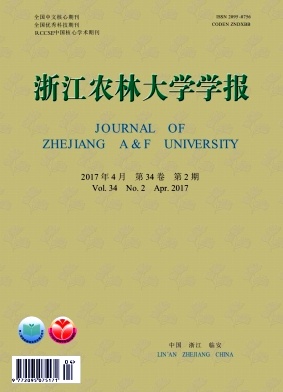-
木材结晶度是指木材中纤维素构成的结晶区占纤维素整体的百分数,表示木材纤维素聚集态形成结晶的程度[1]。它与树木的结构、生长特性及化学组成皆有密切关系,并对木材的密度、硬度及力学性质等具有重要的影响。因此,研究木材结晶度对于从结构与组成上了解木质性质具有指导意义。目前,木材结晶度的测试方法主要有密度法、X-射线衍射法、红外光谱、核磁共振光谱和动力谱学等,其中X-射线衍射法属于绝对法,应用最广泛[2]。然而,该方法相对费时,不适于大批量样本的测定。为此,研究一种快速简便准确的测试方法日益受到各国研究者的关注。近红外(near infrared,NIR)光谱技术是一项快速、准确的无损检测技术,已被广泛应用于药物生产、纸浆造纸、产品检测等各个领域。近红外光谱主要记录含氢基团C—H,O—H,N—H等振动的倍频和合频信息,能反映绝大多数有机化合物的组成和结构性能信息。木材中的纤维素和木质素分子内含有大量含氢基团,在近红外光谱区域有丰富的吸收信息,这是利用近红外光谱法预测木材性质的化学基础。近年来,近红外光谱技术在木材科学研究中的应用也越来越广泛,已被应用到蓝桉Eucalyptus globules,亮果桉Eucalyptus nitens,榆树Ulmus pumila,粗皮桉Eucalyptus pellita,辐射松Pinus radiata,火炬松Pinus taeda,湿地松Pinus elliottii和落叶松Larix gmelinii等树种上,实现了对木材纤维素含量[3]、密度[4-5]、力学性质[6-8]、微纤丝角[9]和木材结晶度[10-12]等性状的预测。杉木Cunninghamia lanceolata是中国南方最重要的速生用材树种之一,分布区涉及湖南、福建、江西、贵州、浙江、广东、广西、四川、湖北、云南、安徽、江苏、河南、陕西、甘肃及台湾等16省(区)[13]。目前,已经就近红外光谱法预测杉木的综纤维素和木质素含量[14]、力学性质[15]、木材强度[16]、微纤丝角[17]、冠层色素含量[18]和叶绿素含量[19]等指标进行了研究,但预测杉木木材结晶度的研究还未见报道。另外,迄今为止杉木木材性状变异规律方面的研究大多基于单株水平[20-23],而基于种源和无性系间的变异研究积累较少,仅有对无性系间力学性质和木材密度变异[24-26]以及种源间木材密度变异[27]的研究。为此,本研究在测定不同地理种源杉木木材样品结晶度的基础上,通过光谱区间选择、光谱预处理组合筛选等建立杉木木材结晶度的近红外预测模型。同时,运用该模型对未知样品进行预测,分析木材结晶度的变异规律,以期为优良无性系选择提供重要依据。
HTML
-
试验材料采自浙江省开化县林场杉木种源种子园,选取来自11个不同地理种源的164个杉木无性系,在样木胸高处(1.3 m)钻取木芯并保证通过髓心,每个无性系按生长年轮取从髓心到树皮方向的第3~20年轮的木材,共取361个样品(包含重复)。试样粉碎后筛分,最后选取过80目筛的木粉备用。
-
试验设备采用XRD6000 X射线衍射仪,X光管为铜靶,用镍片消除CuKα辐射,管电压为40 kV。管电流为30 mA,测量方法采用θ/2θ联动扫描。将80目的木粉样品在室温下压成薄片,然后做2θ的强度曲线,样品扫描范围5°~55°(2θ)角,扫描速度为2°·min-1。利用OriginPro 8软件对扫描的结晶度数据进行作图。木材的结晶度以结晶度指数来衡量,它通过结晶部分占试样整体的百分比来计算。本研究采用Segal法计算杉木木材结晶度(ICr)。ICr=[(I002-Iam)/I002]×100%。其中:ICr为相对结晶度,I002为(002)晶格衍射角的极大强度,Iam为衍射角为18°时非结晶背景衍射的散射强度。
-
实验仪器为美国生产的Nicolet_Antaris傅立叶近红外分析仪,扫描光谱范围为12 000~3 800 cm-1,扫描次数32,分辨率8 cm-1,数据格式为Log1/R。采谱过程中,保持实验室内温度(25 ℃),湿度(60%)基本恒定。
-
应用的软件为TQ Analyst,RESULT-Integration和RESULT-Operation。将待测样品分为校正集、预测集2组,样品光谱数据和结晶度一一对应。模型建立采用偏最小二乘法(PLS),取不同光谱区间与不同光处理类型组合找到最佳的建模组合方式,模型建立后利用预测集进行外部验证,分析预测值与实测值的相关性。最后根据相关系数r,校正均方差(RMSEC)以及预测均方差(RMSEP)来评价模型质量。
-
利用已建成的预测模型,对未参与建模的样品进行结晶度的测定,利用Excel和DPS软件对共计164个无性系(361个样品)结晶度数值进行统计分析,按照无性系和地理种源的不同分析其变异,并进一步在种源和无性系间进行方差分析。
1.1. 试验材料
1.2. X射线衍射仪测定结晶度
1.3. 近红外(NIR)光谱的采集
1.4. 数据分析及预测模型建立
1.5. 木材结晶度变异分析
-
图 1A为杉木木材X射线衍射图,有3个主要的衍射峰,不同样品光谱在衍射峰1和衍射峰2区域差异较大。图 1B为木材结晶度差异较大的2个样品的近红外光谱图。由图 1可知:不同样品具有相似的近红外吸收光谱,近红外吸收谱带相对较宽,而且重叠严重。在低波数(高波长)近红外NIR吸收峰相对较强和尖锐,分辨能力也较好,而在高波数段吸收峰更低,峰形更宽。杉木的主要成分在波数为7 000,5 200,4 700,和4 400 cm-1等4处有较强吸收峰。结果与黄安民等[15]的测定结果一致。
-
根据131个木材样品的结晶度数据,按照结晶度大小梯度选取101个样品作为校正集,用于模型的建立和完全交互验证。剩余30个样品作为预测集,不参与建模,用于建模后的外部验证。由表 1可知:预测集的数据分布均在校正集中。
样本集 数量 平均值/% 最大值/% 最小值/% 标准偏差/% 校正集 101 47.13 50.28 39.81 2.03 预测集 30 44.76 47.14 42.88 1.24 Table 1. Statistical results of wood crystallinity of Cunninghamia lanceolata
-
如果采用全谱数据进行分析,计算工作量比较大,而且在有的光谱区间内样品的信息很弱,与样品的组成间相关性较小,因此,选择合理的光谱范围可减少工作量,同时能提高信噪比和数据分析效率。光谱范围的选择在近红外定量分析模型的建立中是最难的一步,迄今为止化学计量学领域还没有一个完美的算法来选择最佳的光谱范围[28]。最佳光谱区间的选择需要综合考虑光谱特性、采样技术、样品的物理化学性质和分析结果[29]。杉木木材中化学组分复杂,难以从近红外光谱中单独提取某一组分相对应的特征吸收带,因此需要利用样品信息较强的低波数(高波长)范围光谱。实际建模中也发现波数最小值不利于建模,故光谱区间选择从4 100 cm-1开始。表 2为在低波数下的10个不同光谱区域的原始光谱、一阶导数预处理光谱和二阶导数预处理光谱的建模结果,对应的参数为相关系数/校正均方差(r/RMSEC)。结果显示,采用二阶导数预处理光谱,在6 000~4 100 cm-1光谱范围内。预测模型具有相对较好的相关性。
光谱范围/(cm-1) 原始光谱 一阶导数 二阶导数 4 100~8 000 0.637 7/1.52 0.703 2/1.48 0.951 5/0.61 5 000~8 000 0.619 9/1.55 0.399 6/1.81 0.600 0/1.58 6 000~8 000 0.602 4/1.57 0.668 1/1.47 0.247 1/1.91 7 000~8 000 0.574 9/1.61 0.636 8/1.52 0.222 5/1.92 4 100~7 000 0.637 7/1.52 0.673 2/1.46 0.955 2/0.58 5 000~7 000 0.623 5/1.54 0.396 2/1.81 0.570 1/1.62 6 000~7 000 0.444 6/1.76 0.507 1/1.70 0.105 8/1.96 4 100~6 000 0.614 2/1.55 0.659 4/1.48 0.981 3/0.39 5 000~6 000 0.598 7/1.58 0.395 3/1.81 0.489 8/1.72 4 100~5 000 0.642 7/1.51 0.649 4/1.50 0.141 5/1.95 Table 2. Results of modeling with different spectral regions
-
利用近红外定量常用的偏最小二乘法(PLS)和主成分回归法(PCR)作为建模的备选算法。TQ Analyst的光程类型提供了多种方法用于对光程进行定义或校正处理,而光程类型的选择取决于采样的方法。在进行粉末样品近红外漫反射光谱采集时,由于样品颗粒尺寸、均匀性等的影响,光程无法保持恒定,此时需要使用多元信号修正(MSC)或标准则变换(SNV)来对光谱进行处理,以消除这些因素的干扰[30]。光谱预处理在近红外光谱分析中通常是有效且必要的。近红外光谱测量过程中,经常出现光谱偏移或漂移。导数处理是净化谱图较常用的方法,可根据需要进行一阶或二阶微分处理[31-33]。平滑处理可以减少随机噪音,提高模型的稳健性。表 3为在光谱区间6 000~4 100 cm-1时,不同光谱处理组合方式所建立的模型比较结果。采用偏最小二乘、二阶求导和Savitzky-Golay卷积平滑组合对光谱进行预处理,获得了最佳的定量校正模型(图 2),其中校正模型相关系数为0.987 5,校正均方差RMSEC=0.318;预测模型的相关系数为0.921 3,预测均方差RMSEP=0.742。
预处理方法 校正模型 预测模型 RMSEC Rc RMSEP Rp PLS+MSC+ Original 1.970 0.216 0 1.460 0.782 PLS+SNV+ Original 1.970 0.217 5 1.460 0.782 PCR+MSC+ Original 1.750 0.498 8 1.100 0.795 PCR+SNV+ Original 1.760 0.490 7 1.110 0.790 PLS+MSC+ First derivative 1.920 0.3144 1.220 0.850 PLS+SNV+ First derivative 1.990 0.160 3 1.650 0.455 PCR+MSC+ First derivative 1.660 0.565 6 1.340 0.714 PCR+SNV+ First derivative 1.780 0.470 5 1.270 0.698 PLS+MSC+ First derivative +SG 1.990 0.173 6 1.630 0.506 PLS+SNV+ First derivative +SG 1.990 0.166 9 1.640 0.486 PCR+MSC+ First derivative +SG 1.660 0.567 1 1.340 0.714 PCR+SNV+ First derivative +SG 1.780 0.468 3 1.270 0.692 PLS+MSC+ Second derivative 0.366 0.983 4 0.753 0.916 PLS+SNV+ Second derivative 0.369 0.983 2 0.756 0.955 PCR+MSC+ Second derivative 1.880 0.368 6 1.210 0.816 PCR+SNV+ Second derivative 1.880 0.367 8 1.210 0.820 PLS+MSC+ Second derivative +SG 0.318 0.987 5 0.742 0.921 PLS+SNV+ Second derivative +SG 0.318 0.987 5 0.745 0.920 PCR+MSC+ Second derivative +SG 1.870 0.379 6 1.220 0.808 PCR+SNV+ Second derivative +SG 1.870 0.379 1 1.220 0.812 说明:Original为原始光谱;First derivative为一阶求导;Second derivative为二阶求导;SG为Savitzky-Golay卷积平滑。 Table 3. The model parameters in different pretreatment methods
-
为进一步评价模型的质量和测定结果,用30个未参与建模的样品进行外部验证,以确定模型的可靠性和准确性。图 3所示:木材结晶度的实测值和预测值之间的相关系数为0.905 4,有较强的相关性,平均标准偏差为0.301,表明预测结果较好,利用近红外光谱技术建立杉木木材结晶度预测模型是可行的。该模型可以用来预测真实值,实现杉木木材结晶度的快速测定。
-
利用已建成的预测模型和近红外光谱信息对未测定结晶度的230个样品进行预测。表 4给出了11个地理种源杉木木材结晶度的变异情况。按照地理种源分布,杉木木材平均结晶度湖南靖县种源的最小,为43.45%,贵州黎平种源的最大,为45.23%。结晶度的变异系数由大到小依次是广西融水>广西三江>广西柳州>贵州锦屏>广西那坡>湖南靖县=广西河池>湖南会同>贵州天柱>广西南丹>贵州黎平。方差分析显示杉木木材结晶度在种源间无显著差异[F=1.305<F0.05(10, 200)=1.88,表 5]。
地理种源 结晶度/% 变异系数 变幅/% 广西融水 44.24 0.044 41.00~49.75 广西河池 44.07 0.032 42.30~45.77 广西柳州 44.53 0.038 42.95~46.28 广西那坡 45.15 0.034 42.53~47.21 广西南丹 44.59 0.022 43.60~45.52 广西三江 44.59 0.039 41.05~48.01 贵州锦屏 44$62 0.037 41.55~47.10 贵州黎平 45$23 0.009 44.95~45.51 贵州天柱 43$68 0.027 42.50~44.88 湖南会同 44$26 0.027 42.49~45.36 湖南靖县 43$45 0.032 40.49~46.28 总体 44.52 0.031 40.49~49.75 Table 4. Average crystallinity variation of different geographical provenances
图 4为杉木无性系木材结晶度大小分布频次图。对164个杉木无性系样品结晶度大小的结果分析表明:平均值为44.52%,总体变幅为40.49%~49.75%,其中分布在区间42.06%~47.28%的占72.86%。另外,不同杉木无性系间结晶度的差异达极显著水平[F=1.718>F0.01(100, 150)=1.52,表 5]。

Figure 4. The size distribution frequency graph of wood crystallinity of Cunninghamia lanceolata clones
变异来源 平方和 自由度 均方 F值 种源 处理间 28.072 10 2.807 1.305 处理内 600.546 164 3.662 总变异 628.618 174 无性系 处理间 951.179 163 5.835 1.718** 处理内 556.913 164 3.396 总变异 1 508.092 327 说明:F0.05(10, 200)=1.88, F0.01(10, 200)=2.41;F0.05(10, 150)=1.34, F0.01(10, 150)=1.52 Table 5. Variance analysis of wood crystallinity for C. lanceolata provenances and clones
2.1. 杉木木材X射线衍射图和近红外光谱图特征
2.2. 杉木木材结晶度预测模型的建立及评价
2.2.1. 建模样品的选择
2.2.2. 不同光谱区域的筛选
2.2.3. 不同预处理组合的筛选
2.2.4. 杉木木材结晶度模型的外部验证
2.3. 杉木木材结晶度变异分析
-
作为评价材质的重要指标,木材结晶度与木材近红外光谱有很大的相关性。本研究基于近红外光谱技术建立杉木木材结晶度的预测模型,并对不同地理种源的杉木无性系样品进行了预测和变异分析。在应用X衍射技术测定了131个样品结晶度的基础上,用近红外光谱仪获得对应的光谱,经二阶求导和Savitzky-Golay卷积平滑,并选取偏最小二乘法建立了校正模型。当选定光谱区域为6 000~4 100 cm-1时,建立的校正模型预测效果较好,校正模型相关系数为0.987 5,校正均方差RMSEC=0.318;预测模型的相关系数为0.921 3,预测均方差RMSEP=0.742。通过外部验证进一步评价该模型的准确性,杉木木材结晶度的实测值和预测值之间的相关系数为0.905 4,预测结果较好。
对未知的230个杉木样品,按同样方法采集近红外光谱,利用已建成的预测模型进行结晶度的快速测定,进而分析164个无性系间结晶度的变异。来自湖南靖县的无性系平均结晶度最小,为43.45%,贵州黎平种源的最大为45.23%。在11个地理种源中广西融水的变异系数为最大,贵州黎平为最小,但是结晶度在地理种源间无显著差异。不同无性系结晶度的变幅为40.49%~49.75%,且无性系间的差异达极显著水平,显示可在无性系间开展良种选育。木材不同用途对结晶度的要求不尽相同,在造林生产当中可以根据需求选择合适的无性系。虽然木材结晶度对于木材加工具有直接的参考价值,但在林木优良无性系选育过程中单靠单个材性指标选择显然是不足的,下一步应结合其他材质性状开展多性状联合选育研究。










 DownLoad:
DownLoad:


